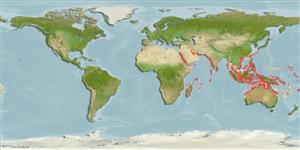>
Acanthuriformes (Surgeonfishes) >
Siganidae (Rabbitfishes)
Etymology: Siganus: Latin, siganus = a fish, rabbit fish; by the similarity of the nose (Ref. 45335).
More on author: Forsskål.
Environment: milieu / climate zone / depth range / distribution range
Écologie
marin récifal; profondeur 1 - ? m (Ref. 9710), usually 5 - 30 m (Ref. 27115). Tropical; 24°C - 28°C (Ref. 27115); 30°N - 35°S
Indian Ocean: Red Sea and East Africa to the Andaman Sea.
Taille / Poids / Âge
Maturity: Lm ? range ? - ? cm
Max length : 40.0 cm TL mâle / non sexé; (Ref. 4407); common length : 35.0 cm TL mâle / non sexé; (Ref. 9813)
Épines dorsales (Total) : 13; Rayons mous dorsaux (Total) : 10; Épines anales: 7; Rayons mous anaux: 9; Vertèbres: 13. Indian Ocean subspecies. S. s. laqueus greyish green with head and body covered with chocolate brown spots; in S. s. stellatus, background color is yellowish. Trailing edges of soft parts of dorsal and anal fins, perimeter of caudal fin and a saddle over the caudal peduncle are markedly paler than the rest. Silvery iris, tinted brown or green, with 10 equally spaced spots. Spines stout; pungent only in juveniles. Preopercular angle 92°-103°. Strong scales cover the cheeks. Usually midline of thorax fully scaled, but pelvic ridges sometimes without scales.
Common in coral reefs; juveniles enter weedy estuaries (Ref. 4407). Juveniles and subadults form schools, adults in pairs. Adults feed on benthic seaweeds (Ref. 9813). Anterolateral glandular grooves with venom gland (Ref. 57406).
Life cycle and mating behavior
Maturité | Reproduction | Frai | Œufs | Fécondité | Larves
Woodland, D.J., 1990. Revision of the fish family Siganidae with descriptions of two new species and comments on distribution and biology. Indo-Pac. Fish. (19):136 p. (Ref. 1419)
Statut dans la liste rouge de l'IUCN (Ref. 130435: Version 2024-2)
Utilisations par l'homme
Pêcheries: commercial; Aquarium: Commercial
Outils
Articles particuliers
Télécharger en XML
Sources Internet
Estimates based on models
Preferred temperature (Ref.
123201): 25.3 - 29.1, mean 28.1 °C (based on 1240 cells).
Phylogenetic diversity index (Ref.
82804): PD
50 = 0.5000 [Uniqueness, from 0.5 = low to 2.0 = high].
Bayesian length-weight: a=0.01514 (0.00816 - 0.02809), b=2.99 (2.83 - 3.15), in cm total length, based on LWR estimates for this species & Genus-body shape (Ref.
93245).
Niveau trophique (Ref.
69278): 2.7 ±0.30 se; based on food items.
Résilience (Ref.
120179): Haut, temps minimum de doublement de population inférieur à 15 mois (Preliminary K or Fecundity.).
Fishing Vulnerability (Ref.
59153): Low to moderate vulnerability (30 of 100).
Nutrients (Ref.
124155): Calcium = 32.4 [14.9, 72.5] mg/100g; Iron = 0.608 [0.294, 1.419] mg/100g; Protein = 18.8 [17.3, 20.3] %; Omega3 = 0.107 [0.055, 0.211] g/100g; Selenium = 21.5 [8.8, 53.9] μg/100g; VitaminA = 32.4 [9.2, 113.5] μg/100g; Zinc = 1.09 [0.43, 2.31] mg/100g (wet weight);
